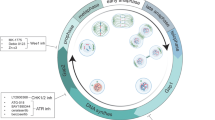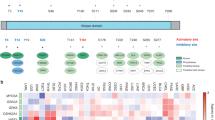Abstract
Cell division is the process by which a cell creates two genetically identical daughter cells. To maintain genomic integrity, a complex and highly regulated sequence of events ensures that the replicated chromosomes are equally partitioned between the daughter cells. For more than 50 years, strategies designed around small-molecule inhibitors have been critical in advancing our understanding of this essential process. Here we introduce a series of questions on the biology of cell division and illustrate how small molecules have been used to design experiments to address these questions. Because of the highly dynamic nature of cell division, the temporal control over protein function that is possible with small molecules has been particularly valuable in dissecting biological mechanisms.
This is a preview of subscription content, access via your institution
Access options
Subscribe to this journal
Receive 12 print issues and online access
$259.00 per year
only $21.58 per issue
Buy this article
- Purchase on Springer Link
- Instant access to full article PDF
Prices may be subject to local taxes which are calculated during checkout






Similar content being viewed by others
References
Kops, G.J., Weaver, B.A. & Cleveland, D.W. On the road to cancer: aneuploidy and the mitotic checkpoint. Nat. Rev. Cancer 5, 773–785 (2005).
Inoue, S. Polarization optical studies of the mitotic spindle. I. The demonstration of spindle fibers in living cells. Chromosoma 5, 487–500 (1953).
Inoue, S. The effect of colchicine on the microscopic and submicroscopic structure of the mitotic spindle. Exp. Cell Res. Suppl. 2, 305 (1952).
Inoue, S. & Sato, H. Cell motility by labile association of molecules. The nature of mitotic spindle fibers and their role in chromosome movement. J. Gen. Physiol. 50 (Suppl.) 259–292 (1967).
Inoue, S. in Primitive Motile Systems in Cell Biology (eds. Allen, R.D. & Kamiya, K.) 549–598 (Academic, New York, 1964).
Inoue, S. Cell division and the mitotic spindle. J. Cell Biol. 91, 131s–147s (1981).
Taylor, E.W. The mechanism of colchicine inhibition of mitosis. I. Kinetics of inhibition and the binding of H3-colchicine. J. Cell Biol. 25 (Suppl.), 145–160 (1965).
Borisy, G.G. & Taylor, E.W. The mechanism of action of colchicine. Binding of colchincine-3H to cellular protein. J. Cell Biol. 34, 525–533 (1967).
Borisy, G.G. & Taylor, E.W. The mechanism of action of colchicine. Colchicine binding to sea urchin eggs and the mitotic apparatus. J. Cell Biol. 34, 535–548 (1967).
Shelanski, M.L. & Taylor, E.W. Isolation of a protein subunit from microtubules. J. Cell Biol. 34, 549–554 (1967).
Weisenberg, R.C., Borisy, G.G. & Taylor, E.W. The colchicine-binding protein of mammalian brain and its relation to microtubules. Biochemistry 7, 4466–4479 (1968).
Mohri, H. Amino-acid composition of 'Tubulin' constituting microtubules of sperm flagella. Nature 217, 1053–1054 (1968).
Mitchison, T.J. & Salmon, E.D. Mitosis: a history of division. Nat. Cell Biol. 3, E17–E21 (2001).
Jordan, M.A. & Wilson, L. Microtubules as a target for anticancer drugs. Nat. Rev. Cancer 4, 253–265 (2004).
Jordan, M.A. et al. Mitotic block induced in HeLa cells by low concentrations of paclitaxel (Taxol) results in abnormal mitotic exit and apoptotic cell death. Cancer Res. 56, 816–825 (1996).
Weaver, B.A. & Cleveland, D.W. Decoding the links between mitosis, cancer, and chemotherapy: The mitotic checkpoint, adaptation, and cell death. Cancer Cell 8, 7–12 (2005).
Tao, W. et al. Induction of apoptosis by an inhibitor of the mitotic kinesin KSP requires both activation of the spindle assembly checkpoint and mitotic slippage. Cancer Cell 8, 49–59 (2005).
Rieder, C.L. & Maiato, H. Stuck in division or passing through: what happens when cells cannot satisfy the spindle assembly checkpoint. Dev. Cell 7, 637–651 (2004).
Hartwell, L.H. & Weinert, T.A. Checkpoints: controls that ensure the order of cell cycle events. Science 246, 629–634 (1989).
Weinert, T.A. & Hartwell, L.H. The RAD9 gene controls the cell cycle response to DNA damage in Saccharomyces cerevisiae. Science 241, 317–322 (1988).
Hoyt, M.A., Totis, L. & Roberts, B.T. S. cerevisiae genes required for cell cycle arrest in response to loss of microtubule function. Cell 66, 507–517 (1991).
Li, R. & Murray, A.W. Feedback control of mitosis in budding yeast. Cell 66, 519–531 (1991).
Hanks, S. et al. Constitutional aneuploidy and cancer predisposition caused by biallelic mutations in BUB1B. Nat. Genet. 36, 1159–1161 (2004).
Mayer, T.U. et al. Small molecule inhibitor of mitotic spindle bipolarity identified in a phenotype-based screen. Science 286, 971–974 (1999).
Canman, J.C. et al. Determining the position of the cell division plane. Nature 424, 1074–1078 (2003).
Sudo, T., Nitta, M., Saya, H. & Ueno, N.T. Dependence of paclitaxel sensitivity on a functional spindle assembly checkpoint. Cancer Res. 64, 2502–2508 (2004).
Rieder, C.L., Schultz, A., Cole, R. & Sluder, G. Anaphase onset in vertebrate somatic cells is controlled by a checkpoint that monitors sister kinetochore attachment to the spindle. J. Cell Biol. 127, 1301–1310 (1994).
Li, X. & Nicklas, R.B. Mitotic forces control a cell-cycle checkpoint. Nature 373, 630–632 (1995).
Waters, J.C., Chen, R.H., Murray, A.W. & Salmon, E.D. Localization of Mad2 to kinetochores depends on microtubule attachment, not tension. J. Cell Biol. 141, 1181–1191 (1998).
Chen, R.H., Waters, J.C., Salmon, E.D. & Murray, A.W. Association of spindle assembly checkpoint component XMAD2 with unattached kinetochores. Science 274, 242–246 (1996).
Li, Y. & Benezra, R. Identification of a human mitotic checkpoint gene: hsMAD2. Science 274, 246–248 (1996).
King, J.M. & Nicklas, R.B. Tension on chromosomes increases the number of kinetochore microtubules but only within limits. J. Cell Sci. 113, 3815–3823 (2000).
Biggins, S. & Murray, A.W. The budding yeast protein kinase Ipl1/Aurora allows the absence of tension to activate the spindle checkpoint. Genes Dev. 15, 3118–3129 (2001).
Meraldi, P., Honda, R. & Nigg, E.A. Aurora kinases link chromosome segregation and cell division to cancer susceptibility. Curr. Opin. Genet. Dev. 14, 29–36 (2004).
Harrington, E.A. et al. VX-680, a potent and selective small-molecule inhibitor of the Aurora kinases, suppresses tumor growth in vivo. Nat. Med. 10, 262–267 (2004).
Hauf, S. et al. The small molecule Hesperadin reveals a role for Aurora B in correcting kinetochore-microtubule attachment and in maintaining the spindle assembly checkpoint. J. Cell Biol. 161, 281–294 (2003).
Ditchfield, C. et al. Aurora B couples chromosome alignment with anaphase by targeting BubR1, Mad2, and Cenp-E to kinetochores. J. Cell Biol. 161, 267–280 (2003).
Biggins, S. et al. The conserved protein kinase Ipl1 regulates microtubule binding to kinetochores in budding yeast. Genes Dev. 13, 532–544 (1999).
Cheeseman, I.M. et al. Phospho-regulation of kinetochore-microtubule attachments by the Aurora kinase Ipl1p. Cell 111, 163–172 (2002).
Cimini, D. et al. Merotelic kinetochore orientation is a major mechanism of aneuploidy in mitotic mammalian tissue cells. J. Cell Biol. 153, 517–527 (2001).
Nicklas, R.B. & Ward, S.C. Elements of error correction in mitosis: microtubule capture, release, and tension. J. Cell Biol. 126, 1241–1253 (1994).
Tanaka, T.U. et al. Evidence that the Ipl1-Sli15 (Aurora kinase-INCENP) complex promotes chromosome bi-orientation by altering kinetochore-spindle pole connections. Cell 108, 317–329 (2002).
Ault, J.G. & Rieder, C.L. Chromosome mal-orientation and reorientation during mitosis. Cell Motil. Cytoskeleton 22, 155–159 (1992).
Carmena, M. & Earnshaw, W.C. The cellular geography of aurora kinases. Nat. Rev. Mol. Cell Biol. 4, 842–854 (2003).
Lampson, M.A., Renduchitala, K., Khodjakov, A. & Kapoor, T.M. Correcting improper chromosome-spindle attachments during cell division. Nat. Cell Biol. 6, 232–237 (2004).
Kapoor, T.M., Mayer, T.U., Coughlin, M.L. & Mitchison, T.J. Probing spindle assembly mechanisms with monastrol, a small molecule inhibitor of the mitotic kinesin, Eg5. J. Cell Biol. 150, 975–988 (2000).
Peterson, J.R. & Mitchison, T.J. Small molecules, big impact: a history of chemical inhibitors and the cytoskeleton. Chem. Biol. 9, 1275–1285 (2002).
Carter, S.B. Effects of cytochalasins on mammalian cells. Nature 213, 261–264 (1967).
Wessells, N.K. et al. Microfilaments in cellular and developmental processes. Science 171, 135–143 (1971).
Spudich, J.A. & Lin, S. Cytochalasin B, its interaction with actin and actomyosin from muscle (cell movement-microfilaments-rabbit striated muscle). Proc. Natl. Acad. Sci. USA 69, 442–446 (1972).
Straight, A.F. et al. Dissecting temporal and spatial control of cytokinesis with a myosin II Inhibitor. Science 299, 1743–1747 (2003).
Martineau, S.N., Andreassen, P.R. & Margolis, R.L. Delay of HeLa cell cleavage into interphase using dihydrocytochalasin B: retention of a postmitotic spindle and telophase disc correlates with synchronous cleavage recovery. J. Cell Biol. 131, 191–205 (1995).
Canman, J.C., Hoffman, D.B. & Salmon, E.D. The role of pre- and post-anaphase microtubules in the cytokinesis phase of the cell cycle. Curr. Biol. 10, 611–614 (2000).
Barr, F.A., Sillje, H.H. & Nigg, E.A. Polo-like kinases and the orchestration of cell division. Nat. Rev. Mol. Cell Biol. 5, 429–440 (2004).
Zhang, J., Campbell, R.E., Ting, A.Y. & Tsien, R.Y. Creating new fluorescent probes for cell biology. Nat. Rev. Mol. Cell Biol. 3, 906–918 (2002).
Acknowledgements
We acknowledge support from US National Institutes of Health grant GM71772 (T.M.K.) M.A.L. is a Francis Goulet fellow.
Author information
Authors and Affiliations
Corresponding author
Ethics declarations
Competing interests
The authors declare no competing financial interests.
Rights and permissions
About this article
Cite this article
Lampson, M., Kapoor, T. Unraveling cell division mechanisms with small-molecule inhibitors. Nat Chem Biol 2, 19–27 (2006). https://doi.org/10.1038/nchembio757
Published:
Issue Date:
DOI: https://doi.org/10.1038/nchembio757
This article is cited by
-
Mandipropamid as a chemical inducer of proximity for in vivo applications
Nature Chemical Biology (2022)
-
Designing a chemical inhibitor for the AAA protein spastin using active site mutations
Nature Chemical Biology (2019)
-
Optogenetic control of kinetochore function
Nature Chemical Biology (2017)
-
Drug-induced cell cycle modulation leading to cell-cycle arrest, nuclear mis-segregation, or endoreplication
BMC Cell Biology (2011)
-
Molecular architecture of the kinetochore–microtubule interface
Nature Reviews Molecular Cell Biology (2008)



